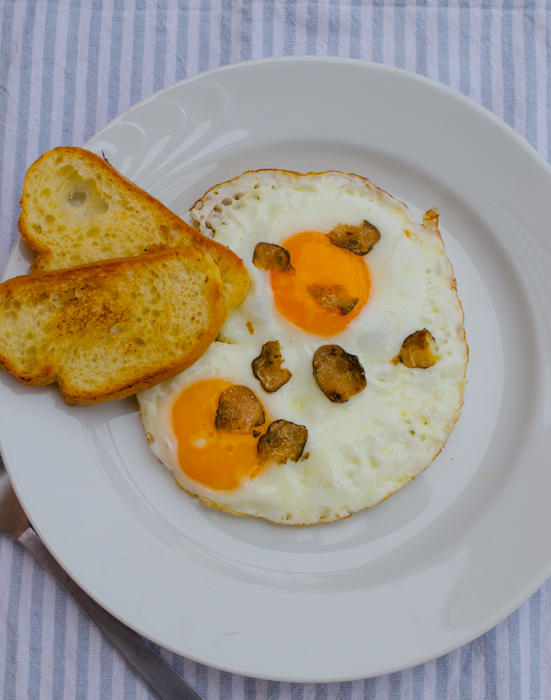 Even the most ordinary of foods can seem special and of higher quality when we experience them in Italy. A question asked over breakfast, as one of our guests cracks open a lovely soft boiled egg and is presented with the creamy yolk,“Why is the egg yolk so orange?” We’ve had many a conversation on this subject, and learned a lot from the various chefs we’ve worked with on our cycling and hiking tours. From them we’ve learned eggs are even named according to the color of their yolks, with yellows referred to as giallo dell’uovo, and the more highly prized orange yolked eggs called rosso d’uovo. But why are the yolks so orange, and why are they better?
Even the most ordinary of foods can seem special and of higher quality when we experience them in Italy. A question asked over breakfast, as one of our guests cracks open a lovely soft boiled egg and is presented with the creamy yolk,“Why is the egg yolk so orange?” We’ve had many a conversation on this subject, and learned a lot from the various chefs we’ve worked with on our cycling and hiking tours. From them we’ve learned eggs are even named according to the color of their yolks, with yellows referred to as giallo dell’uovo, and the more highly prized orange yolked eggs called rosso d’uovo. But why are the yolks so orange, and why are they better?
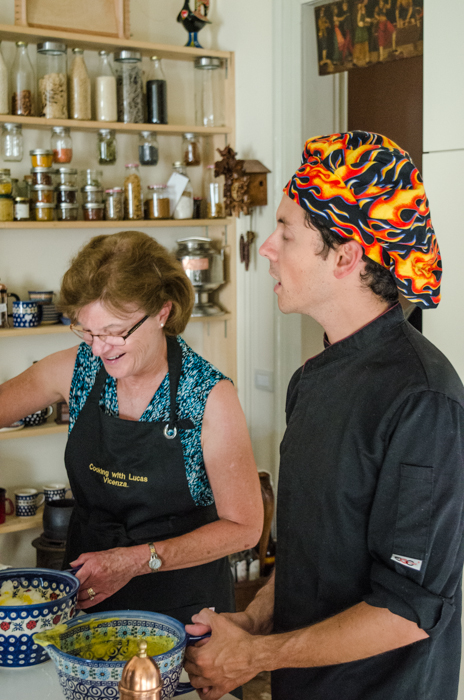
In a 1915 paper in the Journal of Biological Chemistry, Dr. Leroy Palmer identified the chemicals that determine yolk coloring, a class of carotenoids called xanthophylls. Carotenoids are pigment molecules produced primarily by plants, and are only available to animals via diet. They include precursors to vitamin A, and many have been shown to have antioxidant capabilities.
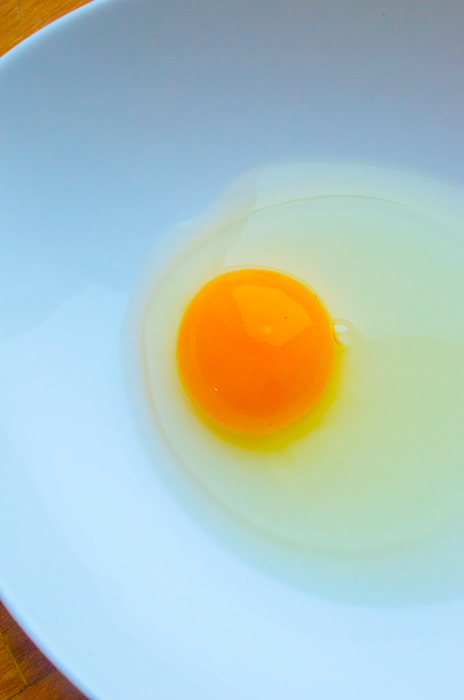 Hens that truly are pasture-raised, foraging on green plants and bugs, have a diet full of these carotenoids. As a result, their yolks have this bright orange color, so this color is a sign of a healthy diet full or nutrients.
Hens that truly are pasture-raised, foraging on green plants and bugs, have a diet full of these carotenoids. As a result, their yolks have this bright orange color, so this color is a sign of a healthy diet full or nutrients.
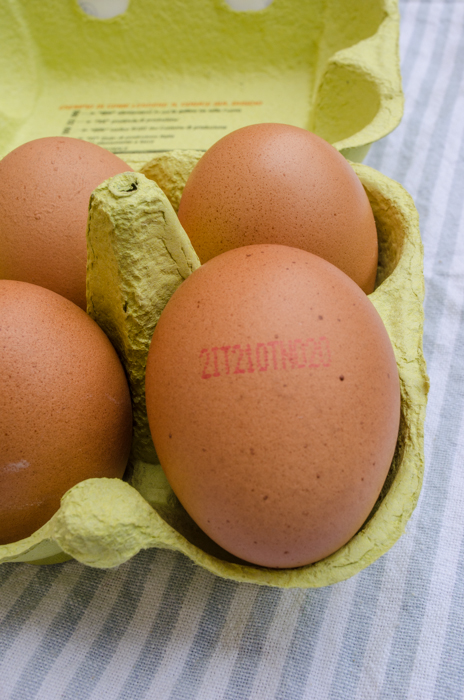 In order to assist European consumers determine the source of their eggs, EU regulations dictate that each egg sold must be marked with an “egg code”, which allows the consumer to identify the source of the egg, the method of production – organic production, free-range, deep litter indoor housing or cage farming – even a registration number indicating the hen laying establishment.
In order to assist European consumers determine the source of their eggs, EU regulations dictate that each egg sold must be marked with an “egg code”, which allows the consumer to identify the source of the egg, the method of production – organic production, free-range, deep litter indoor housing or cage farming – even a registration number indicating the hen laying establishment.
But purchasing an egg from “free-range” hens does not guarantee bright orange yolks. This is because these chickens are not milling around in an open pasture, but in reality only have access to a small patch of dirt devoid of any plant life or bugs to feast upon, that is next to the large barn they share with hundreds of other hens. They are fed a grain based diet, albeit often organic – you’ll see US producers actually advertising that their hens are fed an organic all-vegetarian diet. In Europe, where this orange color is valued, producers sometimes supplement their feed with xanthophylls derived from natural sources, like marigold leaves, orange peels, carrots, annatto seeds, or green feed like alfalfa. So knowing the farm that sources your eggs is important.
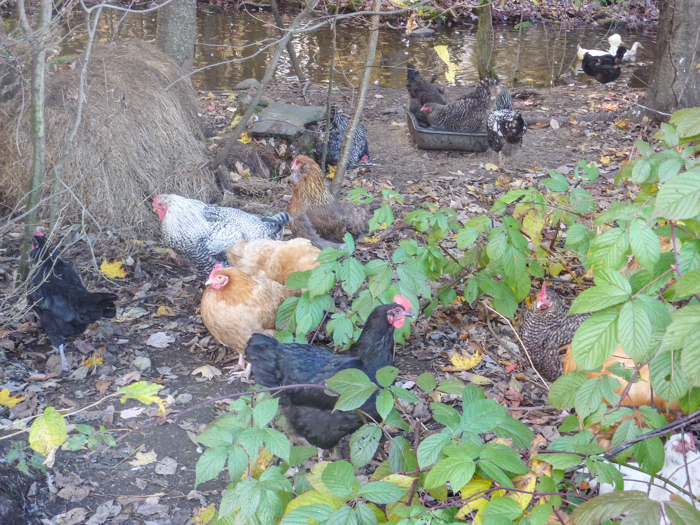 Another interesting difference appears when we go to the market to purchase eggs. We expect to find them in a refrigerated case, as they are sold in the US. Instead, they are on a shelf at room temperature. In order to prevent salmonella, US egg producers are required by the USDA to thoroughly wash the eggs before they go to market. They’re rinsed in hot water, dried and sprayed with a chlorine mist immediately after gathering. This washing removes a thin, naturally occurring coating on the egg, called the cuticle, which prevents any contamination from penetrating the shell. In Europe, producers instead vaccinate laying hens to prevent the transmission of salmonella, and then do not wash the eggs, leaving the protective cuticle intact. Here, refrigeration is actually discouraged, as cooling and then warming could create condensation, which would allow salmonella to penetrate the shell.
Another interesting difference appears when we go to the market to purchase eggs. We expect to find them in a refrigerated case, as they are sold in the US. Instead, they are on a shelf at room temperature. In order to prevent salmonella, US egg producers are required by the USDA to thoroughly wash the eggs before they go to market. They’re rinsed in hot water, dried and sprayed with a chlorine mist immediately after gathering. This washing removes a thin, naturally occurring coating on the egg, called the cuticle, which prevents any contamination from penetrating the shell. In Europe, producers instead vaccinate laying hens to prevent the transmission of salmonella, and then do not wash the eggs, leaving the protective cuticle intact. Here, refrigeration is actually discouraged, as cooling and then warming could create condensation, which would allow salmonella to penetrate the shell.
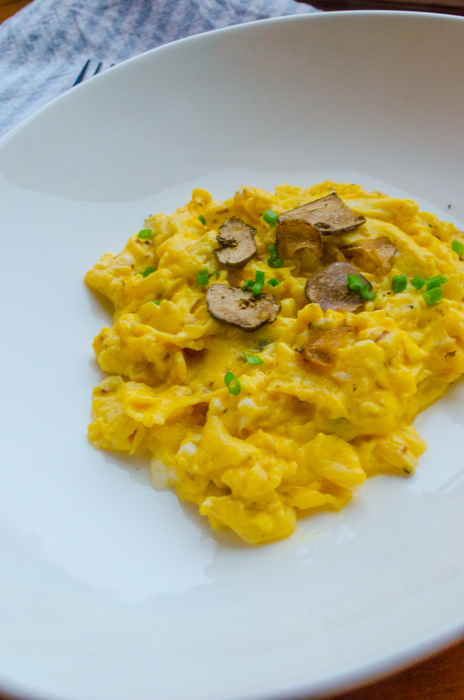 Something as simple as a healthy egg doesn’t need a lot of other ingredients to shine in a dish. Scrambled or fried eggs, garnished with minced chives, or perhaps a shaving of truffles to bring it over the top. A dinner during a visit to Piemonte featured a private table in the kitchen itself, where we were served lovely golden agnolotti, made with only egg yolks. A poached egg topping of a plate of Spaghetti Carbonara. Thankfully, I’m beginning to find eggs like these – great quality, pastured raised, with the signature bright orange yolks – here in the US. And they are, interestingly enough, not necessarily the most expensive egg on sale!
Something as simple as a healthy egg doesn’t need a lot of other ingredients to shine in a dish. Scrambled or fried eggs, garnished with minced chives, or perhaps a shaving of truffles to bring it over the top. A dinner during a visit to Piemonte featured a private table in the kitchen itself, where we were served lovely golden agnolotti, made with only egg yolks. A poached egg topping of a plate of Spaghetti Carbonara. Thankfully, I’m beginning to find eggs like these – great quality, pastured raised, with the signature bright orange yolks – here in the US. And they are, interestingly enough, not necessarily the most expensive egg on sale!
Uova con Tartufo
1 tablespoon unsalted butter
6 large eggs, beaten
Salt and freshly ground pepper
1 tablespoon snipped chives
1 small fresh truffle
In a large nonstick skillet, melt the butter. Add the eggs and season with salt and pepper. Cook over moderate heat, stirring gently until the eggs are creamy with large, soft curds, about 4 minutes. Stir in the chives and place the scrambled eggs onto warmed plates. Thinly shave the truffle all over the scrambled eggs and serve immediately.

Pingback: Tajarin - Rich Egg Pasta from Piedmont | Italian Food, Wine, and Travel